On several occasions NASA has published pictures of Nikon cameras covered in special white housing. Few days ago, I tweeted the picture above but did not know much about it. PopPhoto contacted NASA and got some more details:
“What is all of that extra equipment under the white shroud?
The equipment under the thermal blanket is a Nikon SB-800 flash in a custom housing that is used during a spacewalk (EVA). The flash needed a special housing because it will not work properly in the vacuum of space. The housing holds air pressure so that the flash will function properly. There is also a bracket on the bottom (covered with a white thermal blanket) that the camera and flash mount to.
The separate finder on top is a modified Nikon SB-29 sync cord which allows them to use an auto focus illuminator for low light photography. The pictured Nikon D2Xs camera is a training unit. The actual camera that goes to space has minor firmware and a lubricant modification from a production model.
An update from an insider:
The primary job of the thermal blanket is to shield from direct sunlight(plus other minor factors that we shall overlook), as it would heat up the camera/lens/flash quickly to non-operating temperatures.
The sealed flash housing keeps the air in. But why does a flash need air to work?
1 – the bulb contains a pressurized(sea-level pressure) gas to work. Normally the surrounding air balances the pressure inside, but in an EVA your standard flash bulb will go poof in seconds.
2 – the bulb and the electronics heat up, and normal air cools it because of a phenomenon called thermal convection. Take out the air and you take out the cooling. Of course you could develop a zero-bar bulb and conduction-cooled electronics, but the whole process would be much much costlier. The enclosure does the job.
The lubricant change is necessary because at 0 bar many normal earthly-used lubricants leak gases or light fractions(“outgassing”), and you risk to jeopardize both lubricant performance and the surrounding hardware(for example you could end up with a broken shutter AND a nice greasy spot or fog inside the lens).
The firmware modifications should deal with more extreme lighting conditions and possibly with noise reduction. Earth’s atmosphere shields a lot of nasty cosmic rays and accelerated particles, and when they hit electronics they often translate in spurious voltages that is, more electrical noise.
It’s also unlikely for them to change abruptly the camera/lens/flash model or brand because at this stage they’re all in TRL-9, which means that the hardware is “mission proven”, has reliably done its work many times.








